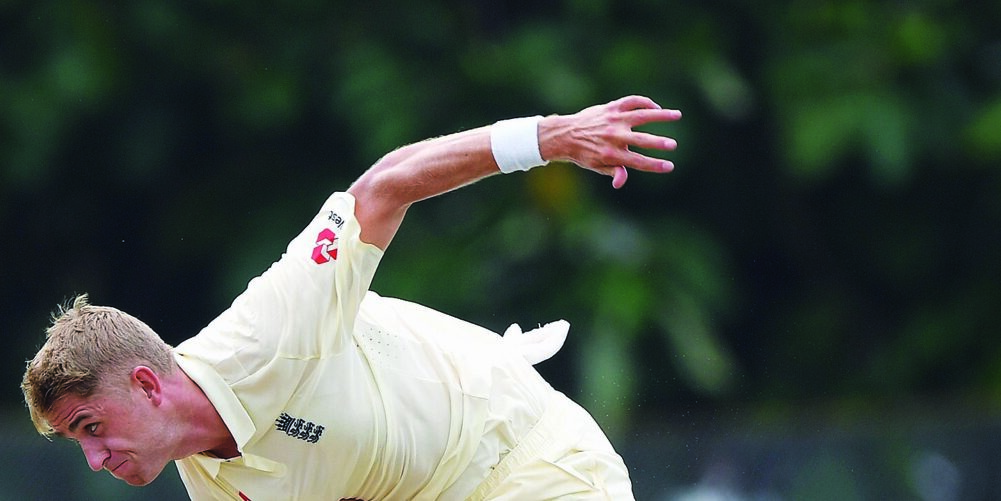Real pace among bowlers unnerves like nothing else on a cricket field. It ruffles the composed, it threatens the bold while demanding of batsmen that they sharpen their faculties with eyes, hands and feet all forced to move more quickly. When functioning at their peak, really fast bowlers have a value and rarity beyond rubies.
Yet, for all that, there is also a fragility borne of the extremes to which they submit their bodies in the pursuit of pace beyond the 90mph mark. It means that injury is rarely far away which is why, after one telling spell in St Lucia, there have been calls to protect Mark Wood in the strongest bubble wrap available, so he can be kept snug, warm and fit for the Ashes in five-and-a-half months’ time.
You can understand the sentiment. Wood touched 95mph in West Indies’ first innings in St Lucia. Trying out a new longer run-up after the old, shorter one kept leading to the surgeon’s table, he discomfited and dismissed five West Indies batsmen, no mean feat in a region where bowling fast and playing it tends to be a rite of passage.
It was thrilling stuff and just the kind of thing, if it could be replicated even semi-regularly, that would complete England’s bowling attack, lacking as it does the means to really intimidate.
But so far, Wood’s searing spell was a one-off, his pace dropping to below 90mph in West Indies’ second innings, when he took just one wicket. But should you protect a bowler on the basis of a single spell no matter how impressive?
Wood is 29 years old, so no young shaver. But he is young in bowling years having played just 51 first-class games, of which the latest was the Test match England won in St Lucia. Injury has been the main reason for such a stuttering career, with three operations on a troublesome left ankle.
But while that may strengthen the case for those who want to keep him swathed in cotton wool inside a padded room until August, I think it would place intolerable mental pressure on him. Who but the idle and entitled would want to be molly-coddled more than the usual precautions of not over-bowling a tear-arse quick bowler? Not the eager and ever popular Wood.
The point is he is still learning how to bowl at the highest level, a more considered process for a bowler of his short stature (5ft 11in) than for one six inches taller, so he needs to play. He doesn’t need to turn out in every game for Durham, his county, but he does need to play enough to stay on the wicket trail.
After all, he is not yet a thoroughbred with a string of match-winning performances behind him and this was only his first five-wicket haul for England in 13 Tests.
Just imagine the extra burden special treatment would place on Wood, who has delivered the decisive blow in a Test just once. For a man whose chirpy character and ready smile hide insecurities, it would be unbearable. Far better for him to bowl and keep his hand in than be pampered and put on a pedestal he does not yet deserve to bestride.
Although fast bowling tends to be the province of the freakishly physically gifted, with their extra share of fast-twitch muscle fibres, hyper-elastic joints and superb co-ordination, it can occasionally be down to brute strength. In the latter case, it might be possible to turn up, well-rested, and turn it on as that method requires little finesse.
Yet, for someone like Wood, will’o’the’wisp thin and with a new run-up, the need for a grooved rhythm is vital and that comes not only from playing, but taking wickets. It is an old-fashioned view but Alec Bedser, medium-fast in comparison to Wood’s greased lightning, reckoned all he needed to do was bowl and keep bowling to be ready for England duty.
Naturally, the rest-is-best lobby will point to Olly Stone, the fast bowler Wood replaced on England’s tour of the West Indies after the former suffered a stress fracture of the back.Stone, 25, is tall, thin and quick but injury prone.
Warwickshire, his current county (he began with Northamptonshire in 2012), have ‘managed’ his workload to the point where he bowled just 161.3 overs in red-ball cricket for them last season.
Remarkably, he took 43 wickets which is a wicket every 23 balls, a strike-rate far greater than the best fast bowlers who have ever played, like Malcolm Marshall.
In 1982, Marshall took 134 wickets in first-class cricket for Hampshire in 822 overs, a strike-rate of a wicket every 36 balls. Stone is clearly a phenomenon but is he really learning the game, or indeed his body hardening to the rigours of top-class cricket, by being so protected? I don’t wish to seem overly dogmatic but exceptional talent is pretty much useless in the context of team sports unless it can be put to regular use.
Perhaps the answer is to alternate Wood and Stone during the season, where they can play every other game for their counties, and then do the same in the Ashes.
Rotation of fast bowlers is still not something that any Test team has yet implemented successfully and to the satisfaction of those involved, but it would enhance the prospect of Wood and Stone staying fit.
A 90mph-plus bowler is certainly something England could do with in order to reach the summit of Mt Ratings again, but they need whoever it is, whether individual or the coalition suggested, to do the business summer and winter for at least three years.
It is a tough ask for, as we have seen, the reality for fast bowlers sometimes being measured in minutes not years.
To work to the satisfaction of all concerned, though, rigour is required and you don’t get that by being kept on ice until the champagne moment arrives.
DEREK PRINGLE | GETTY IMAGES















